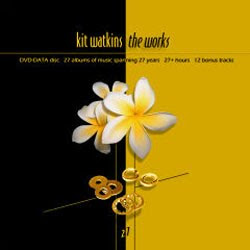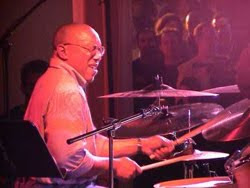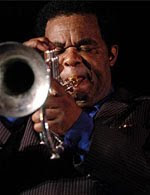 Recently, I received a copy of a fantastic DVD by the the multi-talented musician Kit Watkins entitled, "The Works". This Data/DVD is an incredible collection that spans nearly thirty years of this prolific artist. Watkins first came to my attention on the campus of Georgetown University, during his tenure as founding member of the group, "Happy the Man". Sponsored by the university's then forward thinking radio station, WGTB, Watkins and his group produced a show that is now the stuff of legend and heralded the age of prog-rock and new age music of the late '70's and '80s. There are 27 albums and 12 bonus tracks in mp3 format on the DVD, (including my personal favorite, "Over the Andes" with Coco Rousell), making this a must have collection of a true musical genius.
Recently, I received a copy of a fantastic DVD by the the multi-talented musician Kit Watkins entitled, "The Works". This Data/DVD is an incredible collection that spans nearly thirty years of this prolific artist. Watkins first came to my attention on the campus of Georgetown University, during his tenure as founding member of the group, "Happy the Man". Sponsored by the university's then forward thinking radio station, WGTB, Watkins and his group produced a show that is now the stuff of legend and heralded the age of prog-rock and new age music of the late '70's and '80s. There are 27 albums and 12 bonus tracks in mp3 format on the DVD, (including my personal favorite, "Over the Andes" with Coco Rousell), making this a must have collection of a true musical genius.Another reviewer once wrote of Watkins, "Kit Watkins first came to prominence as part of legendary progressive band, Happy the Man. Despite disbanding years ago after just a couple albums, Kit still gets questions as to if and when this band might ever get back together. Later he joined up with Andrew Latimer in Camel for the album, "I Can See Your House from Here." Shortly afterwards he became a solo artist with his first album, "Labyrinth." From here it was inevitable that Kit would start his own label, Linden Music.
For me, Kit's music is a perfect example of why more artists need to start their own labels. The major labels make it a point to market to the lowest common denominator. An artist on a major label, and even many niche indie labels, must record albums that basically sound the same from beginning to end and from one album to the next. That makes it easy for the labels to market, but denies the artist any artistic growth and eventually cuts short his/her career. Kit refuses to treat his audience in this manner. Instead he assumes that they are both very intelligent and very curious and each album is a new adventure in a totally different musical world."
Born to classical piano teachers in 1953 in Virginia, Kit Watkins studied piano at home from ages 5 through 13. During his teen years, Kit was drawn to rock music and became a driving force behind a series of local bands, playing organ, synthesizer, and flute, as well as singing lead. By age 18, he was discovering his own writing abilities. He soon joined up with the band Happy The Man (HTM) which was forming at the local university. It was with HTM that Kit honed his skills in composing, performing, arranging, and producing. During its six years, the band recorded five albums, including two produced by Ken Scott and released on Arista Records. In 1979, Kit then joined the British band Camel for an album produced by Rupert Hine and several tours of the UK, Europe, and Japan from 1980 through 1982.

Kit’s solo career began in 1980 with the self-produced album Labyrinth, released on his own Azimuth Records label. The album won him 5th place in Keyboard magazine’s Annual Readers’ Poll Awards for keyboard album. He recorded and performed with drummer/percussionist Coco Roussel during this period. During the 80s, Kit continued to produce solo and collaborative albums, some released on his own label, while others were picked up by larger independent labels. In the early 90s, Kit formed a new label, Linden Music, which released a number of his new recordings, as well as CDs by Robert Rich, Jeff Greinke, David Borden, and others.
His music style has changed focus from album to album, and has encompassed such varied forms as progressive, electronica, ambient, jazz, and world-fusion. Some notable influences include artists such as Brian Eno, Mickey Hart, Mark Isham, Joe Zawinul, Harold Budd, Wayne Shorter, Steve Reich, Joni Mitchell, Jon Hassell, Eberhard Weber, Jeff Greinke, Steve Roach, and Wendy Carlos.
In 2001, Kit performed a milestone concert in Philadelphia for The Gatherings series, hosted by Chuck van Zyl of Star’s End Ambient Radio. It was Kit’s first performance in 20 years, and his first ever as a solo artist in a new genre. In preparation for this concert, Kit began learning and using an electronic wind instrument as the focal point of his stage performance. He finds this instrument far more expressive and liberating than electronic keyboards, especially for melody and solo work. Coupling his abilities on flute with his many influences by horn and reed players, the migration to the electronic wind instrument has been a natural. The Gathering CDs are also available, as well as a video of the concert on DVD.
Also in 2001, Kit briefly formed an improvisational ensemble named Tone Ghost Ether. The group was realized through a natural interaction between three musicians (Kit Watkins, Brad Allen, John Tlusty) searching for a common form of expression. All of the music by Tone Ghost Ether was improvised and played in real-time without overdubs.
Kit Watkins is continuing to record and release new works from his private studio in Brattleboro, Vermont. The music of Kit Watkins can be heard on-line at KitWatkins.com, as well as on such broadcast radio shows as Hearts of Space, Star’s End, and Echoes. His wide ranging interests in music and sound allow him to change his focus from album to album resulting in a fresh experience for both artist and listener. Expect the unexpected.


